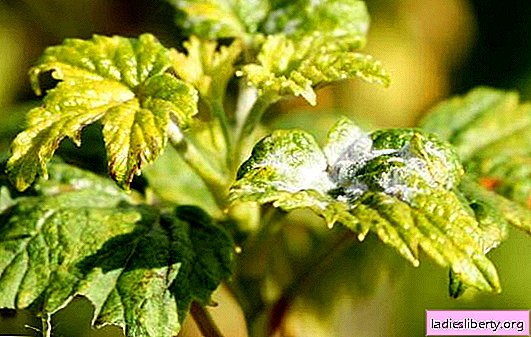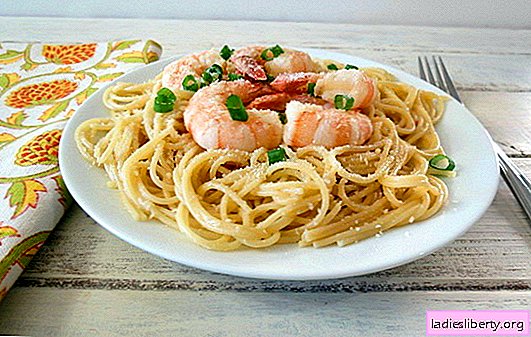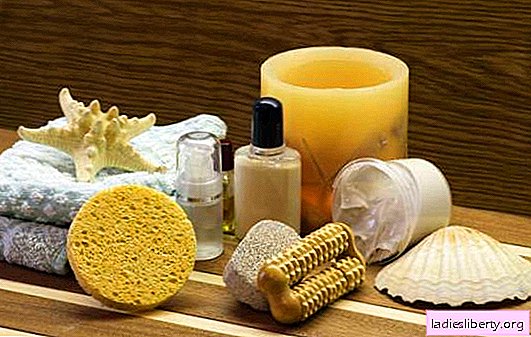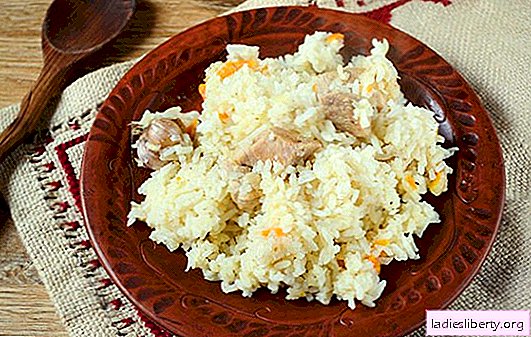
Powdery mildew, or as it is also called ashtray, flour is a disease caused by different types of microscopic ectoparasitic fungi.
What does mildew look like on currants?
Powdery mildew can be easily recognized by the whitish coating on the leaves and shoots, which cannot be erased with your fingers. Infection of the plant begins with the lower leaves and gradually the mycelium spreads to the overlying tissues.

Powdery mildew on currant leaves
With the further development of the disease, spores mature on the mycelium (powdery mildew), droplets of liquid remain after dispersion. Therefore, the disease received the name "powdery mildew." Over time, whitish spots condense and turn brown.
What is the danger of powdery mildew on currants?
Powdery mildew - spreads quickly and can destroy plantings in 1-2 seasons:
• greatly weakens currant bushes (their development stops) and reduces their frost resistance. As a result, even if the plant does not die in the first winter after infection, this will happen by the next season;
• crop sharply decreases - the berries affected by powdery mildew crack, rot, prematurely crumble;
• infected inflorescences do not form berries;
• shoots are deformed, lagging behind in growth, internodes are shortened on them;
• the leaves become smaller, uglier, chlorose (get a marble color) and dry quickly.

Powdery mildew currant berries
How and when does mildew spread?
Powdery mildew infection occurs in late spring or early summer. By this time, spores ripen on the overwintered mycelium, which are spread by wind, insects, raindrops or irrigation water.
Factors such as accelerate the progression of the disease:
• sharp jumps in temperature and humidity (the optimum for the development of powdery mildew is + 20-25 ° C and humidity above 80%);
• excess nitrogen fertilizers;
• low intensity of sunlight (therefore, the disease begins with the lower tiers of the bush).
Under such conditions, leaf turgor decreases, which facilitates the germination of fungal spores in plant tissue. Sick leaves brighten, become fragile, curl up and dry.
Weakened and genetically unstable varieties of currant bushes are "captured" by powdery mildew in the first place.
Powdery Mildew Sources
Sources of infection with the ashtray are summer conidia of the fungus, giving 8-20 generations of spores over the summer. By fall, winter conidia develop, which remain viable for up to 6 years. They hibernate on plant debris (fallen leaves, berries falling, etc.) When favorable conditions (plus air temperature and high humidity) occur, they actively begin to germinate.
Control measures: biofungicides, chemical protection, alternative methods
Powdery mildew is difficult to completely destroy. Therefore, at its first manifestations, one must act immediately. Before processing the currants, cut off all the affected parts of the bush. After this, the plants are sprayed with solutions of drugs that suppress the development of a pathogenic fungus.
Biofungicides
The action of biofungicides is based on the use of different strains of the bacterium Bacillus subtilis, which destroy pathogenic fungi. Such preparations are environmentally friendly both for humans and for animals and beneficial pollinating insects; they can be used even during the ripening of berries. However, they are less effective than chemical preparations: their duration is rather short (7-20 days), they are easily washed off by rain, they must be stored correctly, therefore they are used several times (every week on mildew-sensitive varieties and after 14 days on resistant varieties as a prophylaxis). The most famous biofungicides include Phytosporin, Gamair, Bactofit, Alirin-B, Planriz, Rapsol.
Powdery Mildew Chemicals
To destroy powdery mildew on currants from chemical fungicides, use the following: Topsin-M, Topaz, Fundazol, Skor, Previkur, Acrobat, Rayek.
When using them, it is important to strictly observe the dosage and timing of the treatment of plants. Spraying with solutions of these preparations is carried out in dry, calm weather.
After planned or sanitary pruning, currant bushes and the land around them are irrigated 3% Nitrafen solution (consumption 0.15-0.25 l / 1 m2 of plantings). The drug can cause leaf burns, so spraying is carried out in early spring before the phase of the "green haze" or in autumn after the leaves fall.
From chemicals For the treatment of plants from fungal diseases, the most safe for humans are 1% solutions of copper sulfate, colloidal sulfur, and lime-sulfur broth. Spraying with these drugs is carried out twice: at the stage of budding and after flowering before the formation of ovaries.
Folk remedies
Chemicals in the fight against powdery mildew can be used a limited number of times, so experienced gardeners use time-tested folk remedies:
1. Soap-soda solution
Take 50 g of soda ash or ordinary baking soda and the same amount of household (or liquid) soap (it will be as an adhesive), dissolve in 10 l of hot water and cool before use. Sprinkle currant leaves on both sides. Reprocessing should be done after a week.
2. Decoction of horsetail
100 g of freshly harvested horsetail grass field day insist in 1 liter of water. The resulting infusion is boiled over low heat for 2 hours, cooled and filtered. Such concentrate is stored in the refrigerator (7 days). Before use, it is diluted with water 1: 5. The number of treatments is 3-4, the interval between them is 5 days.
3. Soap emulsion with copper sulfate
Dilute 5 g (1 teaspoon) of copper sulfate in 200 ml of hot water and periodically stirring gently pour into a soap solution (50 g of soap / 10 l of water). The resulting emulsion is sprayed 2-3 times every 7 days with diseased currant bushes.
4. Rapeseed oil
A 1% solution of rapeseed mala (10 mg / l of water) reduces the number of pathogenic fungi 200 times 10-14 days after processing the plants. Use the solution within 2 hours.
5. Fermented milk whey solution
The serum is diluted with water 1:10 and the plants are sprayed three times every 3 days. The film formed on the surface of the leaves prevents the respiration of the mycelium of pathogenic fungi. This method is used only in dry weather.
6. Infusion of mullein
1/3 bucket of cow manure is added with water to the full volume of the container. After 3-4 days, the infusion is diluted with water (1:10). In this form, it is ready for use. The treatment is carried out in the evening after sunset to avoid burns to the plants.
7. Tansy decoction
As a preventive measure against powdery mildew, it is recommended to use a decoction of tansy. 300 g of freshly picked grass (or 30 g of dried) pour 10 l of water for 24 hours. After this, infusion boil for 2 hours over low heat, strain and cool. So decoction in the spring after the snow melts, spray the soil under the currant bushes to destroy the fungus mycelium wintering in the soil.
8. Soap-ash solution
Pour boiling water (10 l) 1 kg of wood ash, leave for 1-2 days. Add 50 g of soap as an adhesive. The bushes are treated twice in 7-10 days.
9. Garlic infusion
Grind ½ bucket of garlic shooters or 250 g of garlic and leave for a day to infuse in 10 liters of water. Filtered currants with filtered infusion so that both sides of the leaves are moistened.
10. A solution of potassium permanganate
At the initial stages of the development of this disease, treatment with a potassium permanganate solution (1/2 teaspoon / per 10 liter bucket of water) will help. Disinfection of currant plantings is carried out three times every 5 days.
11. Mustard solution
2 tablespoons of dry mustard are bred in a bucket of hot water. Spray the plants with a cooled solution.
Prevention of powdery mildew currant disease
As you know, the disease is better to prevent than to cure. Preventive measures against ashtrays include:
• cultivation of resistant to this disease varieties of currants
• a reasonable choice of seedlings (it is safer to buy them in proven nurseries);
• mandatory disinfection of newly acquired seedlings with copper-containing fungicides;
• proper planting of berry bushes (dense plantations create a shadow, the soil under the bushes dries poorly, increased humidity favors the development of pathogenic fungi);
• destruction of weeds (they are reserves of various diseases);
• control of insect pests that are carriers of infections;
• removal and burning of infected parts of the berry shrub;
• sanitary treatment of the site and plantings (collection of plant debris in the fall, removal of diseased specimens, inspection of plantings);
• proper pruning of currant bushes (heavily thinned plants become weakened and more susceptible to disease);
• restriction in feeding (an excess of nitrogen fertilizers enhances the development of fungal diseases, including powdery mildew).











